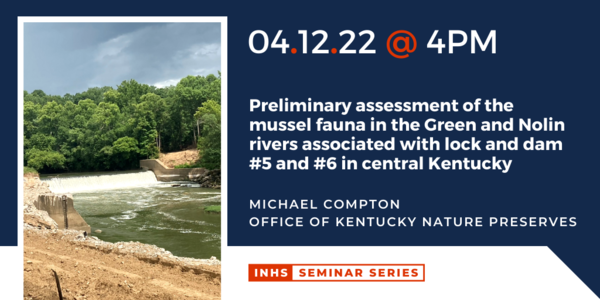
INHS Seminar - Preliminary assessment of the mussel fauna in the Green and Nolin rivers associated with lock and dam #5 and #6 in central Kentucky
- Event Type
- Seminar/Symposium
- Sponsor
- Illinois Natural History Survey Seminar Committee
- Virtual
- Join online
- Date
- Apr 12, 2022 4:00 pm
- Speaker
- Dr. Mike Compton, Aquatic Biologist, Office of Kentucky Nature Preserves, Frankfort, KY
- Contact
- Natalia Maass
- nmaass@illinois.edu
- Views
- 127
- Originating Calendar
- INHS Events
This seminar will be held on campus in room 1005 Forbes Natural History building, or you may join virtually on Zoom: here | Meeting ID: 842 9995 2937 | Password: 280363
Abstract: The Green River is one of the most biologically diverse rivers in the United States. Specifically, over seventy species of freshwater mussels were known from the drainage. However, a series of six navigational dams in the lower portion of the river have altered the hydrology and habitat, which has impacted the mussels. The usefulness of the dams waned by the 1950’s and momentum to remove the decommissioned dams increased. In 2016, lock and dam #6 (LD6) experienced an infrastructure failure and was removed after an urgent public hazard was identified. These events spurred plans to remove lock and dam #5 (LD5) in summer 2022. The removal of the two dams will return 40 km of river to free-flowing conditions. From 2016-2021, a study to document and assess the recovery potential of the mussel fauna along a 75 km section of river associated with the two dams was conducted. The river was delineated into 5 impacted segments that were either above or below one of the dams and a control segment with no direct influence from the dams. Eighty-eight randomly selected sites were surveyed among the segments and were classified as impounded, pool, or shoal habitat. The mussel assemblage at a site was the aggregate of 3 bank-to-bank transects (1-m wide) spaced ten meters apart, which was an approximate 10% subsample. A total of 37 species were identified from the 5,424 live specimens encountered. Nonmetric multidimensional scaling was conducted to assess the assemblage structure among the segments. In addition, comparison of richness and abundance among the segments was made. Some structuring and differences in richness and abundance along the river were seen based on habitat and proximity to LD5. Pool tolerant species were prevalent among each impacted segment. Cyclonaias pustulosa, Megalonaias nervosa, and Pleurobema cordatum were some of the most common species encountered. Six federally listed species were encountered, such as Cyprogenia stegaria and Lampsilis abrupta.